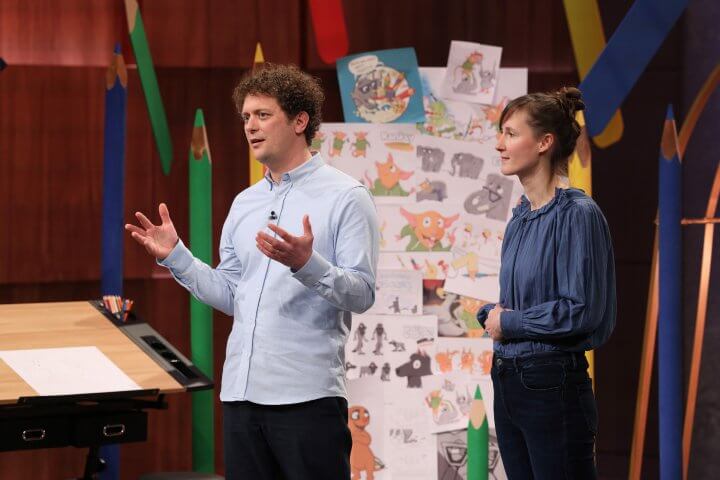Mitmalfilm and the cryptic refusals of the lions #DHDL
Sometimes what a start-up does is just beautiful. The new season of "Die Höhle der Löwen" has just such a theme again with the young company "Mitmalfilm", because here children can have their own drawing become the background of a cartoon film. Unfortunately, however, the figures do not seem to be convincing in certain respects. But what exactly is behind the sometimes somewhat cryptic cancellations by the lions?
Mittwoch,
30.08.2023

At first, things got really artistic during the appearance of „Mitmalfilm“. Because the start-up not only presented its model with the colouring books that children can colour in and then convert to the background of a cartoon film via app, but the lions were even allowed to try it out themselves. Not only was Ralf Dümmel then particularly pleased when he could then watch the short animated film that took place in front of the background he had painted, but the lions also raffled off their pictures. But before five members of the audience could enjoy the lion art, there were still some numbers to be heard – and unfortunately also a number of cancellations to cope with.
Because of course, after the artistic part, it was all about the numbers. The young company already placed its first colouring book on the market in 2020, and sold several hundred books in each of the following years. That doesn’t seem like a lot, but it’s not a reason for much criticism at first.
The margin doesn’t even seem that bad at first. A book with 3 films that can be made from it costs 18 euros, and you can also buy them individually for 9 euros. And even with a low print run, the printing costs for the books here are only 2.87 euros per piece, leaving around 15 euros.
Now you might think that this could be attractive as a business model, and on the surface it even looks like a very good margin. But Ralf Dümmel asks the crucial question, because the printing costs are not at all the decisive factor in this business model; after all, there is also the film that has to be produced. And anyone who paid attention at the beginning of the pitch knows that about 700 drawings have to be made for one minute of animated film.
In fact, such a film, if it is produced to such a high standard, costs around 25,000 euros, according to the founding couple. But one has to be careful, because with this kind of cost it is difficult for many to include it meaningfully in the business model calculation.
For one thing, they are not really variable costs: you cannot calculate the costs down to the individual product sold in advance, because you only pay for the film once, no matter how many books you sell later and how many films are made from it. To illustrate this, let’s take a calculation example: If you sell 100 individual colouring-in films, the 25,000 € production costs are also distributed among these 100 colouring-in templates, which can then be used to make a finished colouring-in film. So you would have to estimate costs of 250 € per product sold. That is, of course, a loss-making business.
But if you sell 25,000 colouring-in pictures, the production costs are also divided among the much larger quantity, so you would only have to deduct a single euro from the margin and thus have a very exciting business.
Such costs are therefore a little tricky in that they cannot be directly deducted from the margin in a specific amount like „normal“ variable costs, but in contrast to „normal“ fixed costs they can already – at least in retrospect – be converted to the individual product and also depend directly on it. If they were treated as pure fixed costs, the whole business model would be distorted and might appear much more advantageous than it actually is.
So with models like this, you always have to keep in mind the corresponding sales prospects and calculate with them. Perhaps this was also a reason why many of the lions justified their exit by saying that they could not provide the sales channels to boost the sales of the colouring books. After all, investors usually work such things out while you are talking to them.
Now, one or two people who work in a creative industry and know a bit about it will already think that there are often good opportunities for such projects in particular to cross-finance the high production costs. Especially in film, subsidies are very popular here, which also works quite well for many smaller companies.
The viewers do not find out whether this could be the case in the specific case of Mitmalfilm, but as a pure thought experiment one can quickly imagine how something like this works: with, for example, 20,000 euros in subsidised costs, „only“ 5,000 euros would remain per film, which the company would have to raise itself. Divided over, say, 1,000 sales, this would still result in 5 euros per product sold, which would still leave a margin. So the business model would be sustainable even with far fewer sales.
If it works like this, it is of course great for the founders, but such subsidised business models are extremely unpopular with investors, because there is of course no guarantee for the subsidies and the scalability of the entire model is also rated as very limited.
But it is of course perfectly fine if something works for founders and companies but not for investors.
For the sweet and great theme of Mitmalfilm, after the exit of all the lions, it remains to be hoped that the founding couple will manage in one way or another to make their model sustainable for themselves – after all, I’m sure many children also want to feel the pride that was so clearly evident to lion Ralf Dümmel during the screening of „his“ film.
Photo (above): TVNOW / Bernd-Michael Maurer

Ruth Cremer
Ruth Cremer ist Mathematikerin und Beraterin sowie Hochschuldozentin auf dem Gebiet der Geschäftsmodelle, Kennzahlen und Finanzplanung. Als ehemalige Investmentmanagerin weiß sie, worauf Investoren achten und hilft auch bei der Pitch- und Dokumentenerstellung im Investitions- oder Übernahmeprozess. Seit 2017 ist sie als externe Beraterin an der Auswahl und Vorbereitung der Kandidaten in "Die Höhle der Löwen" beteiligt.
